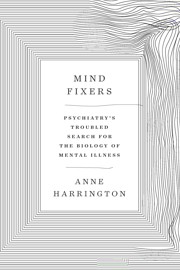Mind Fixers: Psychiatry’s Troubled Search for the Biology of Mental Illness Norton
In 1886, Clark Bell, the editor of the journal of the Medico-Legal Society of New York, relayed to a physician named Pliny Earle a query bound to be of interest to his journal’s readers: Exactly what mental illnesses can be said to exist? In his 50-year career as a psychiatrist, Earle had developed curricula to teach medical students about mental disorders, co-founded the first professional organization of psychiatrists, and opened one of the first private psychiatric practices in the country. He had also run a couple of asylums, where he instituted novel treatment strategies such as providing education to the mentally ill. If any American doctor was in a position to answer Bell’s query, it was Pliny Earle.
Earle responded with a letter unlikely to satisfy Bell. “In the present state of our knowledge,” he wrote, “no classification can be erected upon a pathological basis, for the simple reason that, with slight exceptions, the pathology of the disease is unknown.” Earle’s demurral was also a lament. During his career, he had watched with excitement as medicine, once a discipline rooted in experience and tradition, became a practice based on science. Doctors had treated vaguely named diseases like ague and dropsy with therapies like bloodletting and mustard plasters. Now they deployed chemical agents like vaccines to target diseases identified by their biological causes. But, as Earle knew, psychiatrists could not peer into a microscope to see the biological source of their patients’ suffering, which arose, they assumed, from the brain. They were stuck in the premodern past, dependent on “the apparent mental condition [his emphasis], as judged from the outward manifestations,” to devise diagnoses and treatments.

Some of the episodes Harrington recounts are familiar, such as Egas Moniz’s invention of the lobotomy, which garnered him a Nobel Prize in 1949, at just about the same time that the psychiatrist Walter Freeman was traveling the United States using a surgical tool modeled on an ice pick to perform the operation on hapless asylum inmates. She has retrieved others from history’s dustbin. In the 1930s, for example, insulin was used to render mental patients comatose in hopes that they would wake up relieved of their psychoses. And in at least one case—the deinstitutionalization of mental patients in the 1960s and ’70s—she has given an old story a new twist. That movement, she argues convincingly, was spearheaded not by pill-happy psychiatrists convinced that a bit of Thorazine would restore their patients to full functioning, but by Freudians. They saw the antipsychotic drugs invented in the 1950s as a way to render patients suitable for the outpatient treatment that psychoanalysts were equipped to provide.
From ice baths to Prozac, each development Harrington describes was touted by its originators and adherents as the next great thing—and not without reason. Some people really did emerge from an insulin coma without their delusions; some people really are roused from profound and disabling depressions by a round of electroconvulsive therapy or by antidepressant drugs. But in every case, the treatment came first, often by accident, and the explanation never came at all. The pathological basis of almost all mental disorders remains as unknown today as it was in 1886—unsurprising, given that the brain turns out to be one of the most complex objects in the universe. Even as psychiatrists prescribe a widening variety of treatments, none of them can say exactly why any of these biological therapies work.
It follows that psychiatrists also cannot precisely predict for whom and under what conditions their treatments will work. That is why antipsychotic drugs are routinely prescribed to depressed people, for example, and antidepressants to people with anxiety disorders. Psychiatry remains an empirical discipline, its practitioners as dependent on their (and their colleagues’) experience to figure out what will be effective as Pliny Earle and his colleagues were. Little wonder that the history of such a field—reliant on the authority of scientific medicine even in the absence of scientific findings—is a record not only of promise and setback, but of hubris.
That word does not appear in Mind Fixers, despite its repeated accounts of overreach by enthusiastic doctors who are often the last to recognize the failure of their theories. As Harrington tells us at the outset, she is committed to restraint. “Heroic origin stories and polemical counterstories may give us momentary emotional satisfaction,” she writes. But the result—“tunnel vision, mutual recrimination, and stalemate”—is not very useful. By presenting a just-the-facts narrative of the attempt to find biological sources of mental suffering, particularly in the brain, she hopes to get the “fraught” enterprise of psychiatry back on the path to progress.
Harrington is right to sigh over what has too often proved to be a yelling match between equally deaf opponents—members of an ambitious profession convinced that psychiatry is making strides toward understanding mental illness, and critics who believe it is at best a misguided attempt to help suffering people and at worst a pseudoscience enabling social control at the expense of human dignity. Indeed, since the sides first squared off, more than half a century ago, they seem to have learned little from each other.
As Harrington ably documents, a series of fiascoes highlighted the profession’s continued inability to answer Clark Bell’s question. Among them was the 1973 vote by the American Psychiatric Association declaring that homosexuality was no longer a mental illness. The obvious question—how scientific is a discipline that settles so momentous a problem at the ballot box?—was raised by the usual critics. This time, insurers and government bureaucrats joined in, wondering, often out loud, whether psychiatry warranted their confidence, and the money that went along with it.
The association’s response was to purge its Diagnostic and Statistical Manual of Mental Disorders (DSM) of the Freudian theory that had led it to include homosexuality in the first place. When the third edition of the DSM came out, in 1980, its authors claimed that they had come up with an accurate list of mental illnesses: Shedding the preconceptions that had dominated previous taxonomies, they relied instead on atheoretical descriptions of symptoms. But as Harrington points out, they did have a theory—that mental illness was no more or less than a pathology of the brain. In claiming not to, she argues,
they were being disingenuous. They believed that biological … markers and causes would eventually be discovered for all the true mental disorders. They intended the new descriptive categories to be a prelude to the research that would discover them.
The DSM-3’s gesture at science proved sufficient to restore the reputation of the profession, but those discoveries never followed. Indeed, even as the DSM (now in its fifth edition) remains the backbone of clinical psychiatry—and becomes the everyday glossary of our psychic suffering—knowledge about the biology of the disorders it lists has proved so elusive that the head of the National Institute of Mental Health, in 2013, announced that it would be “re-orienting its research away from DSM categories.”
Harrington’s dispassion as she chronicles the rise and fall of various biological theories of mental illness will make this book of value to historians of medicine. It may even allow critics and advocates of biological psychiatry alike to gain a deeper appreciation of the historical stream in which they are swimming, and to stop trying to drown one another. But her restraint carries a risk: that she will underplay the significance of the troubles she is reporting.
Modern medicine pivots on the promise that portraying human suffering as biological disease will lead to insight and cures. Inescapably, this enterprise has a sociopolitical dimension. To say which of our travails can (and should) come under medicine’s purview is, implicitly if not explicitly, to present a vision of human agency, of the nature of the good life, of who deserves precious social resources like money and compassion. Such questions, of course, aren’t always pressing; the observation that a broken leg is a problem only in a society that requires mobility seems trivial.
But by virtue of its focus on our mental lives, and especially on our subjective experience of the world and ourselves, psychiatry, far more directly than other medical specialties, implicates our conception of who we are and how our lives should be lived. It raises, in short, moral questions. If you convince people that their moods are merely electrochemical noise, you are also telling them what it means to be human, even if you only intend to ease their pain.
Harrington ends her book with a plea that psychiatry become “more modest in focus” and train its attention on the severe mental illnesses, such as schizophrenia, that are currently treated largely in prisons and homeless shelters—an enterprise that she thinks would require the field “to overcome its persistent reductionist habits and commit to an ongoing dialogue with … the social sciences and even the humanities.” This is a reasonable proposal, and it suggests avenues other than medication, such as a renewed effort to create humane and effective long-term asylum treatment. But no matter how evenhandedly she frames this laudable proposal, an industry that has refused to reckon with the full implications of its ambitions or the extent of its failures is unlikely to heed it.

